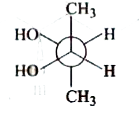Which of the following molecules are chiral?




The correct Answer is:B, C, D
To determine which of the given molecules are chiral, we need to analyze each option based on the criteria for chirality. A molecule is considered chiral if it cannot be superimposed on its mirror image, which typically means it lacks a plane of symmetry and a center of symmetry.
1. Analyze Option A:
- Check for symmetry: Option A has both a plane of symmetry and a center of symmetry.
- Conclusion: Since it has symmetry, Option A is achiral.
2. Analyze Option B:
- Check for symmetry: Option B does not have a plane of symmetry or a center of symmetry.
- Check for chirality: The carbon atom in Option B is bonded to four different groups (OH, CH3, and two other distinct groups).
- Conclusion: Since it lacks symmetry and has four different substituents, Option B is chiral.
3. Analyze Option C:
- Check for symmetry: Option C has a plane of symmetry.
- Conclusion: Because it has symmetry, Option C is achiral.
4. Analyze Option D:
- Check for symmetry: Option D does not have a plane of symmetry or a center of symmetry.
- Check for chirality: Similar to Option B, it has a carbon atom bonded to four different groups.
- Conclusion: Since it lacks symmetry and has four different substituents, Option D is chiral.
Final Conclusion:
- Chiral Molecules: B and D
- Achiral Molecules: A and C
- Check for symmetry: Option A has both a plane of symmetry and a center of symmetry.
- Conclusion: Since it has symmetry, Option A is achiral.
- Check for symmetry: Option B does not have a plane of symmetry or a center of symmetry.
- Check for chirality: The carbon atom in Option B is bonded to four different groups (OH, CH3, and two other distinct groups).
- Conclusion: Since it lacks symmetry and has four different substituents, Option B is chiral.
- Check for symmetry: Option C has a plane of symmetry.
- Conclusion: Because it has symmetry, Option C is achiral.
- Check for symmetry: Option D does not have a plane of symmetry or a center of symmetry.
- Check for chirality: Similar to Option B, it has a carbon atom bonded to four different groups.
- Conclusion: Since it lacks symmetry and has four different substituents, Option D is chiral.
- Chiral Molecules: B and D
- Achiral Molecules: A and C
Similar Questions
Knowledge Check
- Question 1 - Select One
Which of the following dienes is chiral?
ACH3−CH2=C=CH2BCH3−CH=CH−CH=CH2CCH3CH=C=CHCH3DCH2=CH−CH2−CH=CH2 - Question 2 - Select One
Which of the following molecules is/are chiral ?
 AIBIICIIIDI, II
AIBIICIIIDI, II - Question 3 - Select One
Molecules whose mirror image is non-superimposable over them are known as chiral. Which of the following molecules is chiral in nature ?
A2-BromobutaneB1-BromobutaneC2-BromopropaneD2-Bromopropan-2-ol
Which of the following molecule is planer.
View SolutionWhich of the following molecules is linear ?
View SolutionWhich of the following molecules contain a chiral centre?
View SolutionMolecules whose mirror image is non-superimposable over them are known as chiral. Which of the following molecules is chiral in nature?
View SolutionWhich of the following structures is chiral?
View Solution

